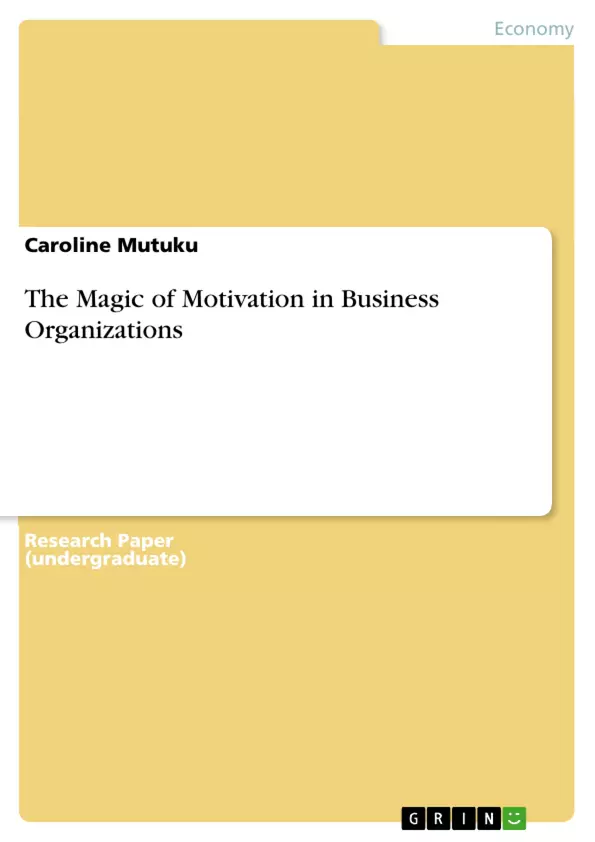Motivation refers to the encouragement given to employees in order to improve their performance or accomplish specified objectives. Motivation can also be defined the power that gives the route to behavior, strengthen or trigger the tendency to work hard (Manzoor, 2012). According to Manzoor (2012), motivation refers to forces within an individual that can affect his/her intensity, persistence of voluntary behavior and intensity. Direction refers to the path while the intensity is the amount of effort allocated towards achieving a certain goal. Motivation is also an internal drive exerted to satisfy an unsatisfied need.
Lack of motivation is manifested by low productivity, low morale, and high incidences of absenteeism, a high number of accidents, tiredness and increasing number of defective products. Based on the above definitions, employees must be satisfactorily energetic with cut objectives. Effective motivation must stimulate both the psychological and physiological want for certain objectives. Motivation must be able to support goal-oriented behaviors. Various theories have been developed to explain motivation in an organization. For instance, the natural versus model tries to explain whether human cognition is related to natural forces such as needs, desires, drives or any kind of rationality.
Table of Contents
- Introduction
- Employee Motivation
- Benefits of Motivation
- Types of Motivation
- Relationship between Rewards, Motivation, Performance and Employee Turnover
- Theories of motivation
- Instrumentalist Theories
- Content Theories
- Maslow's Hierarchy of Human Needs
- Cognitive Theories
- Goal Theory
- Vroom's Expectancy Theory
- Relationship between Motivation and Equity
- Relationship between Motivation and Organizational Justice
- Conclusion
Objectives and Key Themes
The primary objective of this document is to explore the concept of employee motivation within business organizations. The text examines the various types of motivation, outlines its benefits, and explores key theoretical frameworks that explain the dynamics of motivation in the workplace.
- The impact of employee motivation on organizational performance
- Different types of motivation, including intrinsic and extrinsic
- Theories of motivation, such as Maslow's Hierarchy of Needs, Goal Theory, and Expectancy Theory
- The relationship between motivation and organizational justice
- The role of leadership and organizational structures in fostering motivation
Chapter Summaries
- Introduction: This chapter introduces the concept of employee motivation and its importance in business organizations. It defines motivation, its different forms, and outlines the consequences of inadequate motivation.
- Employee Motivation: This chapter delves into the factors that influence employee motivation, highlighting the importance of compensation, rewards, and leadership. The impact of motivation on employee performance and organizational goals is also discussed.
- Benefits of Motivation: This chapter outlines the positive effects of motivation on organizations, including increased efficiency, utilization of human resources, improved employee-organization relationships, workforce stability, and achievement of organizational goals.
- Types of Motivation: This chapter explores the two main categories of motivation: intrinsic and extrinsic. It explains the characteristics of each type and their application in organizations.
- Relationship between Rewards, Motivation, Performance and Employee Turnover: This chapter examines the complex interplay between rewards, motivation, performance, and employee turnover. It explores how various reward systems influence motivation and ultimately impact employee retention.
- Theories of motivation: This chapter delves into different theoretical perspectives on motivation, focusing on instrumentalist theories, content theories, and cognitive theories. It analyzes prominent frameworks like Maslow's Hierarchy of Needs, Goal Theory, and Expectancy Theory.
- Relationship between Motivation and Equity: This chapter explores the link between motivation and the perception of fairness or equity in the workplace. It examines how employees' perceptions of fairness influence their motivation and engagement.
- Relationship between Motivation and Organizational Justice: This chapter examines the role of organizational justice, including distributive, procedural, and interactional justice, in influencing employee motivation. It highlights how a just and equitable work environment can promote employee commitment and productivity.
Keywords
The central themes of this document include employee motivation, organizational performance, different types of motivation (intrinsic and extrinsic), theories of motivation (Maslow's Hierarchy of Needs, Goal Theory, Expectancy Theory), organizational justice, leadership, rewards, and employee turnover.
- Citar trabajo
- Caroline Mutuku (Autor), 2018, The Magic of Motivation in Business Organizations, Múnich, GRIN Verlag, https://www.grin.com/document/429854



